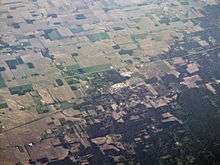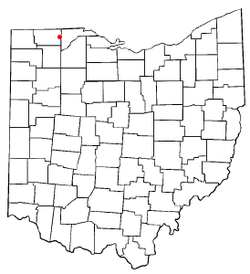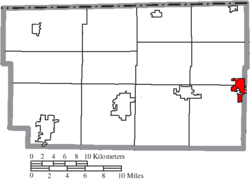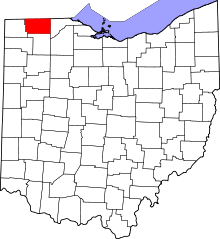Swanton, Ohio
| Swanton, Ohio | |
|---|---|
| Village | |
 Top: Aerial view Bottom: Downtown Swanton. | |
| Motto: "Honoring the past - Committed to the future!" | |
 Location of Swanton, Ohio | |
 Location of Swanton in Fulton County | |
| Coordinates: 41°35′14″N 83°53′29″W / 41.58722°N 83.89139°WCoordinates: 41°35′14″N 83°53′29″W / 41.58722°N 83.89139°W | |
| Country | United States |
| State | Ohio |
| Counties | Fulton, Lucas |
| Townships | Fulton, Swan Creek , Swanton |
| Government | |
| • Mayor | Ann Renee Roth |
| Area[1] | |
| • Total | 3.13 sq mi (8.11 km2) |
| • Land | 3.09 sq mi (8.00 km2) |
| • Water | 0.04 sq mi (0.10 km2) |
| Elevation[2] | 682 ft (208 m) |
| Population (2010)[3] | |
| • Total | 3,690 |
| • Estimate (2012[4]) | 3,690 |
| • Density | 1,194.2/sq mi (461.1/km2) |
| Time zone | Eastern (EST) (UTC-5) |
| • Summer (DST) | EDT (UTC-4) |
| ZIP code | 43558 |
| Area code(s) | 419 Exchanges: 826, 825 |
| FIPS code | 39-75896[5] |
| GNIS feature ID | 1061667[2] |
Swanton is a village in Fulton and Lucas counties in the U.S. state of Ohio. The population was 3,690 at the 2010 census.
History
A post office called Swanton has been in operation since 1827.[6] The village takes its name from nearby Swan Creek.[7]
Geography
Swanton is located at 41°35′14″N 83°53′29″W / 41.587194°N 83.891259°W (41.587194, -83.891259).[8]
According to the United States Census Bureau, the village has a total area of 3.13 square miles (8.11 km2), of which 3.09 square miles (8.00 km2) is land and 0.04 square miles (0.10 km2) is water.[1]
Demographics
| Historical population | |||
|---|---|---|---|
| Census | Pop. | %± | |
| 1880 | 335 | — | |
| 1890 | 508 | 51.6% | |
| 1900 | 887 | 74.6% | |
| 1910 | 1,058 | 19.3% | |
| 1920 | 1,248 | 18.0% | |
| 1930 | 1,505 | 20.6% | |
| 1940 | 1,594 | 5.9% | |
| 1950 | 1,740 | 9.2% | |
| 1960 | 2,306 | 32.5% | |
| 1970 | 2,927 | 26.9% | |
| 1980 | 3,424 | 17.0% | |
| 1990 | 3,557 | 3.9% | |
| 2000 | 3,307 | −7.0% | |
| 2010 | 3,690 | 11.6% | |
| Est. 2015 | 3,886 | [9] | 5.3% |
2010 census
As of the census[3] of 2010, there were 3,690 people, 1,409 households, and 1,018 families residing in the village. The population density was 1,194.2 inhabitants per square mile (461.1/km2). There were 1,498 housing units at an average density of 484.8 per square mile (187.2/km2). The racial makeup of the village was 97.1% White, 0.9% African American, 0.2% Native American, 0.1% Asian, 0.3% from other races, and 1.3% from two or more races. Hispanic or Latino of any race were 3.5% of the population.
There were 1,409 households of which 34.8% had children under the age of 18 living with them, 54.3% were married couples living together, 12.3% had a female householder with no husband present, 5.7% had a male householder with no wife present, and 27.8% were non-families. 22.9% of all households were made up of individuals and 8.6% had someone living alone who was 65 years of age or older. The average household size was 2.56 and the average family size was 2.99.
The median age in the village was 38 years. 26% of residents were under the age of 18; 7.3% were between the ages of 18 and 24; 25.9% were from 25 to 44; 26.9% were from 45 to 64; and 13.9% were 65 years of age or older. The gender makeup of the village was 48.8% male and 51.2% female.
2000 census
As of the census[5] of 2000, there were 3,307 people, 1,241 households, and 903 families residing in the village. The population density was 1,388.0 people per square mile (536.5/km2). There were 1,292 housing units at an average density of 542.3 per square mile (209.6/km2). The racial makeup of the village was 98.43% White, 0.18% African American, 0.18% Native American, 0.18% Asian, 0.60% from other races, and 0.42% from two or more races. Hispanic or Latino of any race were 1.39% of the population.
There were 1,241 households out of which 35.4% had children under the age of 18 living with them, 59.3% were married couples living together, 9.7% had a female householder with no husband present, and 27.2% were non-families. 23.9% of all households were made up of individuals and 11.1% had someone living alone who was 65 years of age or older. The average household size was 2.57 and the average family size was 3.05.
In the village the population was spread out with 26.0% under the age of 18, 7.3% from 18 to 24, 29.0% from 25 to 44, 22.8% from 45 to 64, and 14.8% who were 65 years of age or older. The median age was 37 years. For every 100 females there were 90.6 males. For every 100 females age 18 and over, there were 90.6 males.
The median income for a household in the village was $44,127, and the median income for a family was $55,313. Males had a median income of $40,746 versus $32,207 for females. The per capita income for the village was $20,160. About 1.5% of families and 4.6% of the population were below the poverty line, including 1.4% of those under age 18 and 6.4% of those age 65 or over.
Swanton's Parks
Swanton Memorial Park is home to one of E. M. Viquesney's "Spirit of the American Doughboy" statues. The sculpture was one of several donated as a gift by France to U.S. cities that had lost many soldiers during World War I. It is described as a "Figure of a World War I infantryman advancing through the stumps and barbed wire of No Man's Land. He holds a grenade in his raised proper right hand and a rifle in his proper left hand."[11] The Smithsonian Institution Research Information System lists the statue as being installed in 1926, "administered by City of Swanton, Parks Division, Swanton, Ohio."[12] Also according to the Smithsonian, the inscription on the statue reads as follows: "Spirit of the/American Doughboy"/copyrighted by E. M. Viquesney/Georgia (On stone base:) SWANTON REMEMBERS/TO THE MEMORY/OF THE/VALIANT SONS OF/SWANTON & COMMUNITY/WORLD WAR/1917-1918/THIS MEMORIAL IS/LOVINGLY DEDICATED/WE HOLD THEM IN OUR/GRATEFUL HEARTS WITH/REVERENCE AND HONOR/FOREVER/ERECTED 1926 unsigned.[11]
Memorial Park is home to recreation facilities including several baseball diamonds. Ai Creek runs through it. It also has a few soccer fields. land was donated for use by the McNeill family.
Pilliod Park is located next to Swanton Public Library and is home to Swanton's red caboose, several gazebos, and a paved walkway. During the winter holiday it is home to Swanton's festive light display.
Rotary Park is an offset of Pilliod Park.
Education
Local teenagers attend Swanton High School. Source: http://www.swantonschools.org/administration/boe/
Swanton Corn Festival
Swanton is home to an annual Corn Festival, occurring in late August. The festival has a parade, volleyball competition, singing contest, car show, much food and other festivities, along with the annual All Class high school reunion.
References
- 1 2 "US Gazetteer files 2010". United States Census Bureau. Retrieved 2013-01-06.
- 1 2 "US Board on Geographic Names". United States Geological Survey. 2007-10-25. Retrieved 2008-01-31.
- 1 2 "American FactFinder". United States Census Bureau. Retrieved 2013-01-06.
- ↑ "Population Estimates". United States Census Bureau. Retrieved 2013-06-17.
- 1 2 "American FactFinder". United States Census Bureau. Retrieved 2008-01-31.
- ↑ "Fulton County". Jim Forte Postal History. Retrieved 25 January 2016.
- ↑ Reighard, Frank H. (1920). A Standard History of Fulton County, Ohio (Volume 1). Lewis Publishing Company. p. 459.
- ↑ "US Gazetteer files: 2010, 2000, and 1990". United States Census Bureau. 2011-02-12. Retrieved 2011-04-23.
- ↑ "Annual Estimates of the Resident Population for Incorporated Places: April 1, 2010 to July 1, 2015". Retrieved July 2, 2016.
- ↑ "Census of Population and Housing". Census.gov. Retrieved June 4, 2015.
- 1 2 The Spirit of the American Doughboy, (sculpture)
- ↑ SIRIS-Smithsonian Institution Research Information System
External links
- Village website
- Swanton Public Library
- Swanton Local School District
- Swanton Chamber of Commerce
- Tourism Website

